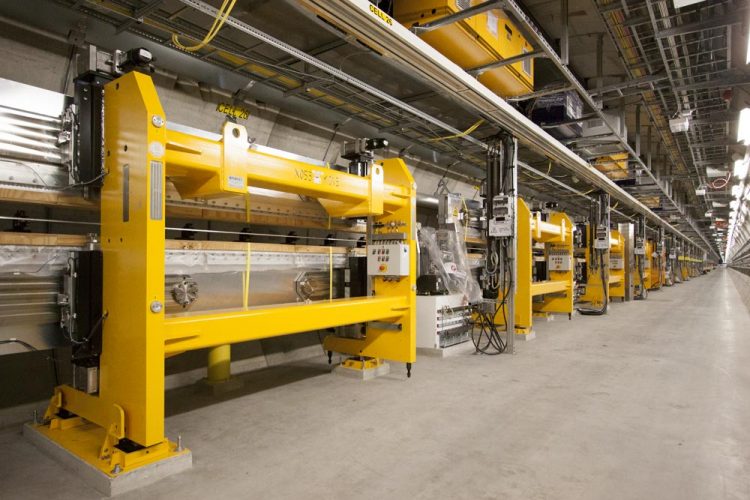All segments of first light-generating system installed in world’s brightest X-ray laser

Undulator segments in the photon tunnel on 11 January 2016
The undulator installation is a major step towards the completion of the European XFEL, a 3.4 km-long X-ray free-electron laser facility that will be the world’s brightest X-ray source when completed. It is also one of Europe’s largest research projects and is due to open to users for research in 2017.
“With the 35 segments of the first undulator beam line in place, we have clearly reached a very important milestone in the construction of our facility”, says European XFEL Managing Director Prof. Massimo Altarelli. “The X-ray flashes produced in these systems are the basis for the future research at the European XFEL. We are looking forward to 2017, when they will be used to investigate the smallest details of the structure and function of matter in the molecular world.”
Each of the 35 segments is 5 m long, weighs 7.5 t, and is composed of two girders facing one another, each holding a line of alternating strong permanent magnets. When accelerated electrons pass through the field of alternating polarity generated by the magnets, ultrashort flashes of X-ray laser light are produced. Components between adjacent segments help ensure a consistent magnetic field between them, and control systems allow mechanical movement of components within the undulator, which allows generation of a large spectrum of photon wavelengths.
Design, development, and prototyping work started approximately eight years ago in a joint collaboration with DESY, European XFEL’s largest shareholder. The same technology is also used in a number of projects at DESY, including the X-ray free-electron laser FLASH and the PETRA III storage ring light source.
The undulator system was built through a multinational collaboration. The challenging production involved DESY and Russian, German, Swiss, Italian, Slovenian, Swedish, and Chinese institutes and companies under the leadership of the undulator group of the European XFEL. This includes a number in-kind contributions such as electromagnets for the electron beamline designed and manufactured at several institutes in Russia and tested in Sweden; temperature monitoring units from the Manne Siegbahn Laboratory in Sweden; and movers, phase shifters, and control systems designed and manufactured by the research centre CIEMAT in Spain.
“This was a true synergetic collaboration”, says Joachim Pflüger, group leader of the European XFEL undulator group. “The resources and experience of DESY were essential for the development of the undulator systems. Now there is a great mutual benefit!”
This first completed undulator will generate short-wavelength “hard” X-rays that will be used for experiments with a focus on structural biology and ultrafast chemistry. All three of the undulators planned for the starting phase of the European XFEL will be operational by the end of 2016.
About European XFEL
The European XFEL, currently under construction in the Hamburg area, will be an international research facility of superlatives: 27 000 X-ray flashes per second and a brilliance that is a billion times higher than that of the best conventional X-ray sources will open up completely new opportunities for science. Research groups from around the world will be able to map the atomic details of viruses, decipher the molecular composition of cells, take three-dimensional “photos” of the nanoworld, “film” chemical reactions, and study processes such as those occurring deep inside planets. The construction and operation of the facility is entrusted to the European XFEL GmbH, a non-profit company that cooperates closely with the research centre DESY and other organizations worldwide. By the time the facility starts user operation in 2017, the company will have a workforce of about 280 employees. With construction and commissioning costs of 1.22 billion euro (at 2005 price levels) and a total length of 3.4 kilometres, the European XFEL is one of the largest and most ambitious European research projects to date. At present, 11 countries have signed the European XFEL convention: Denmark, France, Germany, Hungary, Italy, Poland, Russia, Slovakia, Spain, Sweden, and Switzerland.
Press contact:
Dr. Bernd Ebeling
+49 40 8998 6921
+49 40 8998 2020 Fax
press@xfel.eu
https://media.xfel.eu/XFELmediabank/?l=en&c=14087 Pictures of the undulator segments
http://www.xfel.eu More about European XFEL
Media Contact
More Information:
http://www.xfel.euAll latest news from the category: Physics and Astronomy
This area deals with the fundamental laws and building blocks of nature and how they interact, the properties and the behavior of matter, and research into space and time and their structures.
innovations-report provides in-depth reports and articles on subjects such as astrophysics, laser technologies, nuclear, quantum, particle and solid-state physics, nanotechnologies, planetary research and findings (Mars, Venus) and developments related to the Hubble Telescope.
Newest articles

Bringing bio-inspired robots to life
Nebraska researcher Eric Markvicka gets NSF CAREER Award to pursue manufacture of novel materials for soft robotics and stretchable electronics. Engineers are increasingly eager to develop robots that mimic the…

Bella moths use poison to attract mates
Scientists are closer to finding out how. Pyrrolizidine alkaloids are as bitter and toxic as they are hard to pronounce. They’re produced by several different types of plants and are…

AI tool creates ‘synthetic’ images of cells
…for enhanced microscopy analysis. Observing individual cells through microscopes can reveal a range of important cell biological phenomena that frequently play a role in human diseases, but the process of…





















